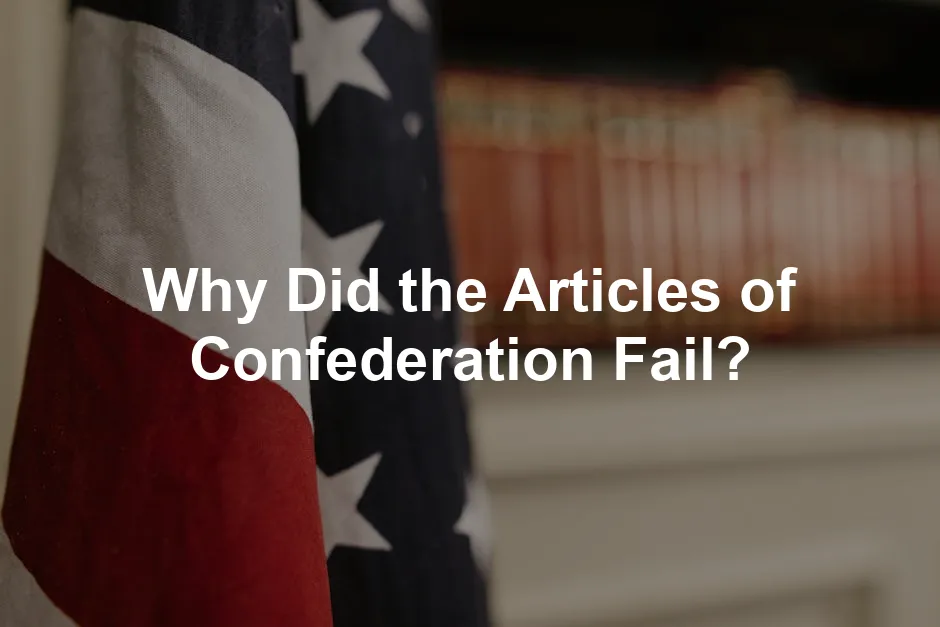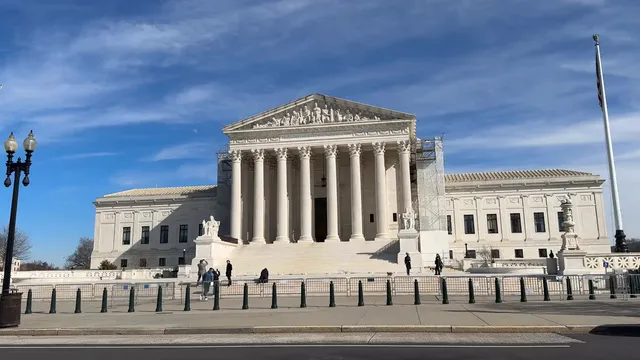
Why Did the Articles of Confederation Fail?
Introduction
The Articles of Confederation served as America’s first constitution. They aimed to unite the thirteen colonies after the Revolutionary War. But why did this governing document fail so quickly? The shortcomings led to a transition to the U.S. Constitution in 1789, which addressed these critical issues.
If you’re curious about the historical context, dive into The Federalist Papers by Alexander Hamilton, James Madison, and John Jay. These foundational texts provide insight into the motivations behind the Constitution and the weaknesses of the Articles.
Summary and Overview
The Articles of Confederation were created during a time of uncertainty. The Continental Congress drafted them in 1777, and all thirteen states ratified them by 1781. Initially, the Articles aimed to foster unity among the states while ensuring their sovereignty. However, the new nation faced significant challenges, including economic instability and weak governance.

Several primary reasons contributed to the failure of the Articles. Firstly, Congress lacked the power to tax, relying on voluntary state contributions. This led to financial chaos and inability to repay war debts. Secondly, the absence of a strong central authority meant that the federal government could not enforce laws. Lastly, the requirement for a supermajority to pass legislation created gridlock, paralyzing the legislative process. These factors ultimately pushed leaders to seek a more effective governing framework.
Understanding why the Articles of Confederation failed is crucial to grasping the evolution of American governance. why did the articles of confederation fail
For an engaging read on the founding fathers and their struggles, I recommend Founding Brothers: The Revolutionary Generation by Joseph J. Ellis. It provides a fascinating look at the relationships between key figures during the American Revolution.
Historical Context of the Articles of Confederation
The Articles of Confederation emerged in a tumultuous time. After the Revolutionary War, the newly independent states sought to create a government. The urgency for governance stemmed from the chaos following years of conflict. Delegates met at the Second Continental Congress, drafting the Articles in 1777. They aimed to unify the thirteen states but faced significant challenges.

Fears of a strong central government loomed large. The American colonists had endured oppressive rule under the British Crown. They were wary of repeating that experience. This apprehension shaped the Articles, emphasizing state sovereignty over national authority. Each state wanted to retain as much power as possible.
Key events also influenced the Articles’ adoption. The British capture of Philadelphia in 1777 heightened the urgency for a new government structure. Delegates recognized the need for a coordinated approach to governance. Despite their limitations, the Articles were ratified by all thirteen states by March 1781. This governing framework aimed to provide a sense of unity while allowing states to maintain independence.
If you’re interested in this pivotal moment in history, consider exploring the historical documents related to the Articles of Confederation. They offer valuable insights into the early American government and its challenges. You can find an excellent resource in The Constitutional Convention: A Narrative History from the Notes of James Madison by Edward J. Larson.

Key Features of the Articles of Confederation
The Articles of Confederation laid the groundwork for the United States’ first governing framework. This document established a unicameral legislature, meaning there was only one legislative body. Each state had one vote, which reinforced the emphasis on state sovereignty. However, this structure led to serious legislative inefficiencies.
The Articles granted specific powers to Congress. It could conduct foreign affairs, declare war, and manage diplomacy. However, Congress lacked the authority to levy taxes or regulate commerce. This absence of power created significant challenges for the new nation. The reliance on voluntary state contributions often resulted in insufficient funding.

The amendment process was also a major hurdle. Any changes to the Articles required unanimous consent from all thirteen states. This made it nearly impossible to adapt the governing framework to changing needs. The Articles emphasized a weak central government, which ultimately hindered effective governance.
For those looking to understand the intricacies of this early American government, further reading on the Articles’ text and structure can provide a deeper perspective on its intended powers and limitations. Consider checking out A People’s History of the New United States by David Zarefsky for a broader understanding of American history.

Major Weaknesses of the Articles
Lack of Central Authority
The Articles of Confederation lacked a central executive branch. This absence meant there was no one to enforce laws or manage national issues. Without an executive leader, the government struggled to address problems effectively.
This weakness became evident in various crises. For instance, during Shays’ Rebellion in 1786, the government couldn’t respond quickly. Congress had no power to raise a national army. This inability illustrated the dire consequences of weak central authority. The lack of leadership led to chaos, as states acted independently, often in conflicting ways. Consequently, the government failed to unify the nation and protect its citizens, highlighting the critical need for a more robust governing structure.

For more on this pivotal event, check out Shays’ Rebellion: The Making of an Agrarian Insurrection by Leonard L. Richards; it provides deep insights into the causes and effects of this uprising.
Legislative Inefficiencies
Under the Articles, passing laws proved incredibly challenging. Each state had one vote in Congress, regardless of size. This setup created significant legislative gridlock. A supermajority of nine out of thirteen states was required to enact any law. This high threshold made it easy for a minority to block necessary legislation.

For example, Congress struggled to pass laws addressing economic challenges after the Revolutionary War. Many proposals faced rejection, leaving the nation without crucial financial support. Additionally, the amendment process was equally cumbersome. Unanimous consent was necessary to make changes, stalling any progress. This legislative inefficiency underscored the Articles’ shortcomings, ultimately leading to calls for reform and the creation of a stronger Constitution.
Economic Disorganization
The Articles of Confederation faced serious economic challenges. One major issue was the federal government’s inability to levy taxes. Without the authority to collect taxes, Congress relied on voluntary contributions from the states. This system led to severe funding shortfalls. For instance, by 1786, the national debt had ballooned to over $34 million, yet Congress could barely scrape together enough to operate.

State tariffs further complicated matters. Each state imposed its own trade barriers, disrupting commerce. States often taxed goods coming from neighboring states, creating a fragmented marketplace. This resulted in trade deficits, as businesses struggled to operate under inconsistent regulations. The lack of a common currency only worsened the situation. Each state printed its own money, which led to confusion and a lack of trust in the economy.
As a result, the young nation struggled to manage its finances. Economic disorganization hindered growth and made it difficult to pay off debts incurred during the Revolutionary War. Many Americans faced unemployment and poverty, leading to social unrest. Without a coordinated economic strategy, the Articles were doomed to fail, highlighting the urgent need for a stronger central authority.

Shays’ Rebellion and Its Significance
Shays’ Rebellion erupted in 1786, driven by economic distress among farmers in Massachusetts. Many veterans, struggling with debt and high taxes, felt abandoned by the government. They were outraged when their lands were seized due to unpaid taxes. This discontent led Daniel Shays to rally fellow farmers, creating a significant insurrection.

The rebellion quickly revealed the weaknesses of the Articles of Confederation. The federal government had no standing army to suppress the uprising. Congress struggled to respond effectively, relying on state militias that were often unprepared. This inaction alarmed many leaders, including George Washington, who recognized the perilous state of the nation.
As news of the rebellion spread, public perception shifted. Many began to view the Articles as inadequate for maintaining order and addressing citizens’ needs. Shays’ Rebellion served as a wake-up call, highlighting the need for a stronger national government capable of enforcing laws and ensuring stability. This event catalyzed discussions for reform, ultimately leading to the Constitutional Convention of 1787. Analyzing the repercussions of Shays’ Rebellion sheds light on the path toward a more effective and unified governance structure.

To gain further insight into this pivotal event, consider reading The American Revolution: A History by Gordon S. Wood, which provides a comprehensive overview of the era.
The Path to Reform: The Constitutional Convention
As the weaknesses of the Articles of Confederation became evident, calls for reform grew louder. The tipping point was Shays’ Rebellion in 1786. This uprising exposed the government’s inability to maintain order and respond to economic distress. Leaders recognized that a stronger federal government was essential.

In response, a meeting took place in Annapolis, Maryland, in September 1786. Delegates from five states gathered to discuss amendments to the Articles. Key figures included Alexander Hamilton and James Madison. They advocated for a more robust national structure. However, they realized that simply amending the Articles would not suffice. A more radical solution was needed.
Thus, the Constitutional Convention convened in Philadelphia in May 1787. Delegates from twelve states participated, aiming to create a new governing framework. They sought to balance state and federal powers. This gathering included prominent figures like George Washington and Benjamin Franklin, who played crucial roles in shaping the Constitution.

The Convention had clear goals: to address economic instability, create a stronger central government, and establish a system of checks and balances. They worked through intense debates and compromises. The result was a new Constitution that significantly redefined the American government.
If you’re interested, dive into the debates and compromises that emerged during the Convention. They laid the foundation for the U.S. government we know today. For an excellent overview, check out The U.S. Constitution: A Very Short Introduction by David Armitage.
Conclusion
The Articles of Confederation failed due to significant weaknesses. A lack of central authority, legislative inefficiencies, and economic disorganization hindered effective governance. Learning from these historical lessons is crucial for informing our current system. The legacy of the Articles ultimately shaped the U.S. Constitution, emphasizing the need for a balanced government that protects both state and national interests.
Please let us know what you think about our content by leaving a comment down below!
Thank you for reading till here 🙂
All images from Pexels




